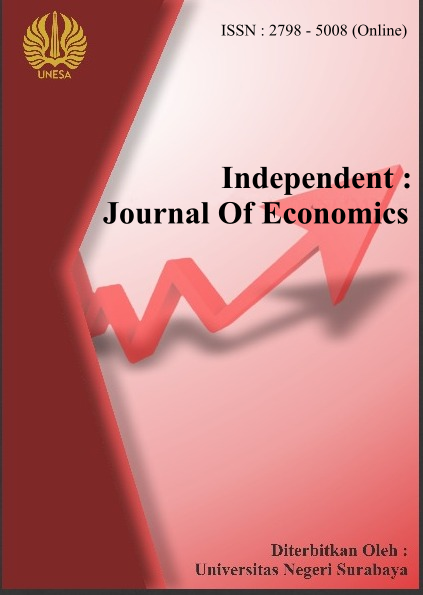Implementasi Pembangunan Ekonomi di Indonesia Bersifat Unsustainable?
Abstract
Sustainable development is a measure of development that takes into account economic, social and environmental aspects. The achievement of measuring development with GDP is unable to measure people's welfare and does not take into account aspects of environmental damage. Development in Indonesia is short-term and suffers from a trap of progress that damages the environment. This study aims to measure the achievements of sustainable development in Indonesia using the sustainable development index. The results of the study using the IPB 2 scenario are better than scenario 1. Based on scenario 2, it is unsustainable development with a sloping u-inverted curve according to the environmental kuznet curve hypothesis. Research shows that achieving sustainable development is shown by balancing the rate of growth with the rate of population. In achieving sustainable development, measures of sustainable development are needed for the scope of areas that are environmentally sound, as well as the implementation of carbon tax policies.
References
Alisjahbana, A. S., & Yusuf, A. A. (2004). Assessing Indonesia´ s Sustainable Development: Long‑ Run Trend, Impact of the Crisis, and Adjustment during the Recovery Period. Asean Economic Bulletin, 21(3), 290–307. https://doi.org/10.1355/ae21-3c
Arsyad, L. (2015). Ekonomi Pembangunan (5th ed.). UPP STIM YKPN.
Bali, R. S., & Yang-Wallentin, F. (2020). Achieving sustainable development goals: predicaments and strategies. International Journal of Sustainable Development and World Ecology, 27(2), 96–106. https://doi.org/10.1080/13504509.2019.1692316
Bapppenas. (2019). Target Low Carbon.
Bashir, A., Husni Thamrin, K. M., Farhan, M., Mukhlis, & Atiyatna, D. P. (2019). The causality between human capital, energy consumption, CO 2 emissions, and economic growth: Empirical evidence from Indonesia. International Journal of Energy Economics and Policy, 9(2), 98–104. https://doi.org/10.32479/ijeep.7377
Beckerman, W. (1992). Economic Growth and the Environment : Whose Growth ? Whose Environment ? World Development, 20(4), 481–496.
BPS. (2014). Pertumbuhan Ekonomi.
Cahyono, H. (2020). Riwayat Pemikiran Maestro Ekonomi Dunia. Meja Tamu.
Callan, S. J. T. J. M. (2013). Environmental Economics & Management: Theory, Policy and Applications.
Drabsch, T. (2012). Measuring wellbeing Briefing Paper No 4 / 2012 by Talina Drabsch. Briefing Paper NSW Parliamentary Research Service, 4, 1–44. https://www.parliament.nsw.gov.au/researchpapers/Documents/measuring-wellbeing/Wellbeing.pdf
Erlinda, N. (2016). Kebijakan pembangunan wilayah berkelanjutan di provinsi jambi melalui pendekatan model flag. Jurnal Ekonomi Dan Kebijakan Publik, 7(1), 1. https://doi.org/10.22212/jekp.v7i1.416
Fauzi, A., & Oktavianus, A. (2014). Pergerakan pembangunan berkelanjutan di Indonesia. In Mimbar (Vol. 30, Issue 1, pp. 45–52). https://ejournal.unisba.ac.id/index.php/mimbar/article/view/445/759
Fauzi, A., & Oktavianus, A. (2015). Background Study Rpjmn 2015-2019 Indeks Pembangunan Lingkungan Hidup.
Fauzi, A., & Oxtavianus, A. (2014). The Measurement of Sustainable Development in Indonesia Pengukuran Pembangunan Berkelanjutan di Indonesia. 15.
Febriana, S., Diartho, H. C., & Istiyani, N. (2019). Hubungan pembangunan ekonomi terhadap kualitas lingkungan hidup di provinsi jawa timur. Jurnal Dinamika Ekonomi Pembangunan, 2(2), 58–70.
Grossman, G. M., & Krueger, A. B. (1991). Environmental impacts of a North American free trade agreement. NBER Working Paper 3914. NBER Cambridge, 3914.
Gyamfi, B. A., Adedoyin, F. F., Bein, M. A., & Bekun, F. V. (2021). Environmental implications of N-shaped environmental Kuznets curve for E7 countries. Environmental Science and Pollution Research, 28(25), 33072–33082. https://doi.org/10.1007/s11356-021-12967-x
Huang, B., & Xu, Y. (2014). Environmental performances in Asia: overview, drivers, and policy implications. Asian Development Bank INstitute, 990, 75–75. https://doi.org/10.1007/978-1-349-67278-3_116
Indicators, W. D. (2021). GDP Current LCU. World Bank.
Indonesia, W. R. I. (2022). Nilai Gas Rumah Kaca Terbesar di Dunia.
KLHK. (2017). Laporan Inventarisasi Gas Rumah Kaca dan MRV Nasional 2017. http://ditjenppi.menlhk.go.id/berita-ppi/3150-kontribusi-penurunan-emisi-grk-nasional,-menuju-ndc-2030.html
Leal Filho, W., Azeiteiro, U., Alves, F., Pace, P., Mifsud, M., Brandli, L., Caeiro, S. S., & Disterheft, A. (2018). Reinvigorating the sustainable development research agenda: the role of the sustainable development goals (SDG). International Journal of Sustainable Development and World Ecology, 25(2), 131–142. https://doi.org/10.1080/13504509.2017.1342103
Nikensari, S. I., Destilawati, S., & Nurjanah, S. (2019). Studi Environmental Kuznets Curve Di Asia: Sebelum Dan Setelah Millennium Development Goals. Jurnal Ekonomi Pembangunan, 27(2), 11–25. https://doi.org/10.14203/jep.27.2.2019.11-25
Nordhaus, W., & James, T. (1973). The Measurement of Economic and Social Performance.
Nuansa, C. G., & Widodo, W. (2018). Environmental Kuznets Curve Hypothesis : A Perspective of Sustainable Development in Indonesia. 09021, 1–5.
Nugraha, A. T., & Osman, N. H. (2019). CO 2 Emissions , Economic Growth , Energy Consumption , and Household Expenditure for Indonesia : Evidence from Cointegration and Vector Error Correction Model. 9(1), 291–298.
Panayotou, T. (1993). Empirical tests and policy analysis of environmental degradation at different stages of economic development. In Pacific and Asian Journal of Energy (Vol. 4, Issue 1).
Perman, R., Ma, Y., Common, M., Maddison, D., & McGilvray, J. (2003). Natural Resource and Environmental Economics (Third Edition). In Natural Resource and Environmental Economics. http://econdse.org/wp-content/uploads/2014/01/perman_et_al_chapters_6_and_7.pdf
Pratiwi, N., Santoso, D. budi, & Ashar, K. (2018). Analisis implementasi pembangunan berkelanjutan di Jawa Timur. Jiep, 18(1), 1–13.
Purjayanto, Y. (2022). Analisis pengaruh pembangunan ekonomi, kualitas sumber daya manusia, dan kepadatan penduduk terhadap kerusakan lingkungan di pulau jawa (. BESTARI:Buletin Statistika Dan Aplikasi Terkini, III, 21–27.
Suparmoko, M. (2020). Konsep pembangunan berkelanjutan dalam perencanaan pembangunan nasional dan regional. Jurnal Ekonomika Dan Manajemen, 9(1), 39–50. https://journal.budiluhur.ac.id/index.php/ema/article/download/1112/814
UNDP. (2021). Human Development Index. https://hdr.undp.org/data-center/human-development-index#/indicies/HDI
Warren, M., Hergoualc’h, K., Kauffman, J. B., Murdiyarso, D., & Kolka, R. (2017). An appraisal of Indonesia’s immense peat carbon stock using national peatland maps: Uncertainties and potential losses from conversion. Carbon Balance and Management, 12(1), 1–12. https://doi.org/10.1186/s13021-017-0080-2
Copyright (c) 2022 Wella Amalia Yanuarti, Lucky Rachmawati

This work is licensed under a Creative Commons Attribution 4.0 International License.
 Abstract Views: 120
Abstract Views: 120 PDF Downloads: 224
PDF Downloads: 224













